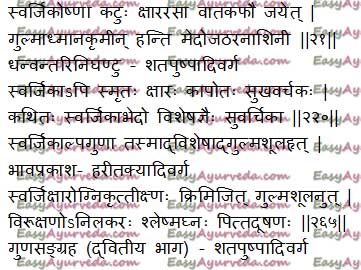By Dr Renita D’Souza
Swarjika kshara (Sajjikhar) is an Ayurvedic medicine mainly indicated in abdominal colic pain and abdominal lump (gulma). It is an alkali prepared from specific species of plant.
Table of Contents
ToggleIntroduction
Svarjika kshara is obtained by burning alkali-rich plant (Lona / Lana) found in Punjab, Sindh Pradesh or by burning alkali-rich plant that grows on the beach. Some people opine that it is obtained from Dhobi Mati. But fractions of salt are also found in it. It is difficult to separate alkali from it. This plant contains salt and it is difficult to separate from the alkali.
Vernacular names, Synonyms
Vernacular Names
Hindi Name – Sajji, Sajikhar, Sajjimitti
Kannada Name – Saajjikharu, Saajjikhar, Sajjikhar
Gujrathi Name – Saajjikhar
Marati Name – Sajjikhar
Bengali Name – Saajikhar, Saajimaati
Panjabi Name – Sajji, Lota sajji
English Name – Sodium carbonate
Sanskrit Synonyms
Swarjika, Kshara, Kaapotha, Suvarchaka
Suvarchika, svarji, svarjaka, sarjjee, suvarchaka, suvarcha, sukorjika, roochaka.
Qualities, Sanskrit sloka
Medicinal Properties of Swarjik Kshar
Taste (rasa) – Pungent (katu), kshararasa (alkaline taste)
Virya (potency) – Ushna (hot)
Guna (quality) – Laghu (light), Tikshna (penetrating in nature)
Karma (action)
Deepana – Kindles the digestive fire
Pachana – Improves digestion
Effect on doshas –
Balances vata and kapha dosha due to its ushna (hot) quality.
Aggravates pitta

Indication
Indications of Swarjika kshara
Gulma – abdominal lump, flatulence
Shula – abdominal colic
Aadmana – Bloating
Krimi – worm infestation
Medojataranashini – Used in obesity. Reduces fat accumulated in abdominal abdominal region.
Indigestion
Gastritis
Skin diseases
Mutrakrichra – difficulty in micturition
Cough
Asthma
Rheumatoid arthritis
Properties –
तीक्ष्णोष्णौ लघु रूक्षश्च क्लेदी पक्ता विदारण: ।
दाहनो दीपनश्छेत्ता स्वर्ज्जिक्षारोऽग्नि सन्निभ: ॥ – (च.सू.अ.२७)
tīkṣṇoṣṇau laghu rūkṣaśca kledī paktā vidāraṇa: |
dāhano dīpanaśchettā svarjjikṣāro’gni sannibha: || – (ca.sū.a.27)
tīkṣṇa – sharp,
uṣṇa – hot,
laghu – light,
rūkṣa – dry,
kledī – liquefying,
paktā vidāraṇa:
dāhano
dīpana – carminative,
agni sannibha: – has similar qualities of Agni or fire
According to acharya Sushruta –
śukra śleṣma – dimishes the quantity of semen and Kapha dosha,
Vibandha – constipation,
arśa – hemorrhoids,
gulma – abdominal lump
plīha – splenic disorders
Preparation, Purification
Swarjika Kshara preparation
Swarjika kshara is an alkali preparation obtained from the plants growing in sodium rich soils or the plants of Salsola and other species. The plant is dried and burnt in a pit where the clay pot with the hole made at the bottom is placed upside down over the other vessel. The thin liquid gets collected in the pot is left for some days to cool down.
The portion which is collected outside the pot is impure and that which gets collected inside the pot is called lotasajji.
Caroxylon griffithii plant which is commonly known as Kangan khar plant yields the pure and best alkali which is used in the form of medicine.
Purification of Swarjika kshara
Swarjikakshara is purified before using it in any medicinal form.
Method – The impure alkali is mixed with double quantity of water and boiled. The upper hot liquid portion is filtered and dried in low flame in an enamel vessel. The remaining portion of liquid is mixed with water, boiled and upper liquid portion is filtered and again dried in low flame.
The alkali prepared is mixed with hot water and dried to obtain pure swarjikakshara.
Storage – Stored in air tight container.
Quality – Swarjikakshara has similar features but low quality when compared to yavakshara.
Read – Yavakshara Benefits, Dosage, Side Effects, Ingredients, Reference
Simple method of Purification of Svarjika kshara
Svarjika kshara should be mixed with water and stirred well. Then it should be filtered through a cloth for five to six times and should be heated till all the water content gets evaporated. By this method, Svarjika kshara gets purified.
Features, Dose, Side effects
Features of Swarjik kshar
Color – white
Odour – odourless
Form – powder
Dose of Swarjika kshar
3 to 12 ratti (375 mg to 1.5 grams) in divides doses per day
With western medicines
Seek your doctor’s advice if you are taking this product along with other western (allopathic/modern) medicines. Some Ayurvedic herbs can interact with modern medicine.
If both Ayurvedic and allopathic medicines are advised together, then it is best to take allopathic medicine first, wait for 30 minutes and then, after a gap of 15 – 30 minutes, take Ayurvedic medicine
Can this be used while taking Homeopathic medicine?
Yes. This product does not react with homeopathic medicine.
With supplements like multivitamin tablets, Omega 3 fatty acids etc?
Yes. Generally, this product goes well with most of the dietary supplements. However, if you are taking more than one product per day, please consult your doctor for an opinion.
Side Effects of sajjikshar
Due to its hot and pitta aggravating property it is avoided in bleeding disorders, burning sensation and high pitta conditions.
It is avoided in children, emaciated and underweight person. It reduces the quality and quantity of sperm due to its khsara (alkaline) quality.
In high dose it causes gastrointestinal irritation, burning sensation.
It is avoided in pregnancy and lactation.
Category, Medicines
Classical categorisation
Bhavaprakasha – Swarchikakshara is included in Harithkyadi varga
Dhanvantari Nighantu – Shatapushpadi Varga
Kaiyadeva Nighantu – Dhatu Varga
Shodala Nighantu – Shatapushpadi Varga
Ayurvedic medicines containing Swarjikakshara
Hinguvachadi Choornam – Widely used in anorexia, indigestion, malabsorption syndrome, bloating, loss of appetite, diarrhoea,
asthma, cough, abdominal pain etc
Dadhika Ghrita – It is herbal ghee used in dysuria, ascites, malabsorption syndrome, bloating, vataja gulma, colic, catches, asthma, piles, loss of appetite etc
Click to Consult Dr Renita D’Souza
Please consult your doctor before taking this medicine.
This article is written by Dr. Janardhana V Hebbar BAMS, MD (Ayu), PGDPSM, Managing Director, Easy Ayurveda Hospital.
It is reviewed by Dr. Raviganesh Mogra BAMS, MD (Ayu), Chief Medical Officer, Easy Ayurveda Hospital








